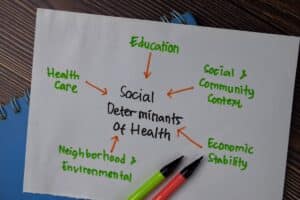Addressing social determinants of health (SDoH) has become an overarching goal in American healthcare, particularly among regulators. What’s fueling these efforts, and why is it important? And what tools do healthcare organizations have at their disposal to address social determinants in a way that actively improves education, engagement, outcomes and other key process indicators?
Why addressing social determinants of health is important
So, what are social determinants of health, and why do that matter? According to the World Health Organization (WHO), SDoH are the “non-medical factors” that affect overall health outcomes. Education, housing status, incarceration history, access to transportation and the ability to sustain employment are all major social determinants, but they’re not the only ones.
For instance, in the United States a person’s financial situation directly affects not only the quality of care they receive, but, in some cases, whether they can receive care at all. Cultural differentiators sometimes present obstacles to care, too. For instance, immigrant, African American, LGBTQ+ and other communities regularly report difficulties with everything from language barriers to racial discrimination.
Going in for an annual checkup is rarely a priority for someone who’s struggling to maintain housing, for example — when it’s even possible at all. What’s more, people suffering from food or housing scarcity are more liable to suffer from malnutrition, chronic stress and the inability to maintain employment, all of which only put them at heightened risk for chronic disease and other unfavorable health conditions.
Although relatively unknown a decade or so ago, the concept of social determinants is now widely understood and accepted throughout the industry. From the leadership suite to the essential workers delivering care, SDoH is understood to be an active factor in every patient’s health — and one that’s costly to ignore.
Over the years, a wealth of research has contributed to this understanding. As the California Telehealth Resource Center (CTRC) points out, we now understand that actual healthcare accounts for only 10 to 20 percent of an individual’s health status. In other words, social determinants of health are responsible for as much as 90 percent of the health status for Americans.
What can healthcare providers do to address SDoH?

Addressing social determinants of health doesn’t just help people and communities, then, but reduces unnecessary utilization and helps providers focus on providing care when and where it’s needed most, making it a worthy goal for healthcare leaders. But what can they actually do to help solve a problem that is, by definition, outside of the realm of healthcare delivery?
Understanding that true solutions lie in improving social conditions, much of the discussion around addressing social determinants of health centers on legislative and regulatory action. For instance, the Center for Medicare & Medicaid Services (CMS) has issued guidance for leveraging federal law to address SDoH, and offers support to states in “designing programs, benefits, and services that can more effectively improve population health and reduce the cost of caring for our nation’s most vulnerable and high-risk populations.”
Those efforts have been paying off; as the Kaiser Family Foundation points out, “a recent survey of Medicaid managed care plans found that almost all (91%) responding plans reported activities to address social determinants of health.”
Yet there are other, more direct ways that all healthcare organizations can contribute to addressing social determinants of health. And one of them is the promotion of remote care technology like remote patient monitoring (RPM).
Addressing social determinants of health with remote patient monitoring
Although it’s been around for decades, remote patient monitoring (RPM) has been used more and more in recent years to specifically address social determinants of health in patient populations. Indeed, experts now agree that telehealth “can help address disparities in access to healthcare services and health outcomes,” as the Agency for Healthcare Research and Quality (AHRQ) states on its website.
It does this in a number of ways. For instance, the ability to receive care remotely means patients don’t have to find transportation to and from a clinic, hospital or other facility. By reducing the costs of managing populations and enabling more treatment of high-acuity patients, remote care can help organizations expand their services to more patients, while providing resources to develop accessibility.
“Telehealth has the potential to become an important tool to address longstanding health inequities in the historically marginalized racial and ethnic groups that have been disproportionately affected by the COVID-19 pandemic.” — Tanya Albert Henry, American Medical Association (AMA).
Because RPM is designed for the remote management of chronic conditions with intuitive, at-home medical devices designed for ease of use, what was once a costly hospital stay for patients can now be experienced affordably, from the comfort of home. All in all, that makes quality care available more widely available for everyone, across all income levels and cultural divides.
Remote patient monitoring programs can help improve health literacy among patients. By providing the means and encouragement to engage in their health on a daily basis, and milestones to work towards, RPM programs can also encourage self-management but also keep providers better informed about populations that might otherwise have difficulty staying engaged because of other social issues.
Remote care tools offer the chance to offer more targeted educational opportunities, which can help engage patients and promote medication adherence. Because of its improved connectivity, remote care can also help clinicians build and maintain closer relationships with their patients than traditional care typically allows — a particular advantage among populations that have been typically difficult to engage.
And RPM has been increasingly used to help postpartum care in areas of the country with high mortality rates often found in poorer communities. It can help new mothers and their infants receive high-quality care no matter where they are, including close monitoring of postpartum hypertension and medication intake, as well as more frequent in-person appointments.
But, although most patients can access care digitally, it isn’t quite universal yet. Indeed, access to telecommunications and digital literacy are themselves often listed as a social determinant of health.
“Without intentional action to help mitigate digital barriers associated with age, race, location, preferred language, and socioeconomic status, permanent expansion of telehealth could have the unintended consequence of reinforcing existing inequities in health access in our highest risk and most underserved communities,” as Health Affairs pointed out in 2021.
In our next article, we’ll talk about how healthcare organizations who are embracing digital care can do just that, and help to ensure health equity in the remote care solutions they offer.
Addressing social determinants of health with RPM solutions from CareSimple
As a leading provider of RPM solutions, CareSimple specializes in helping healthcare operators leverage technology in service of the goals that matter most — including addressing social determinants of health in the populations they serve. If you’re interested in learning more about how we can help your organization, we invite you to take a closer look at our solutions by scheduling a free demo today.
And if you’re looking for a complete guide to remote patient monitoring, don’t miss our new Ultimate Guide to RPM, offering everything from basic definitions to detailed looks at cost payment models that use remote care technology.
